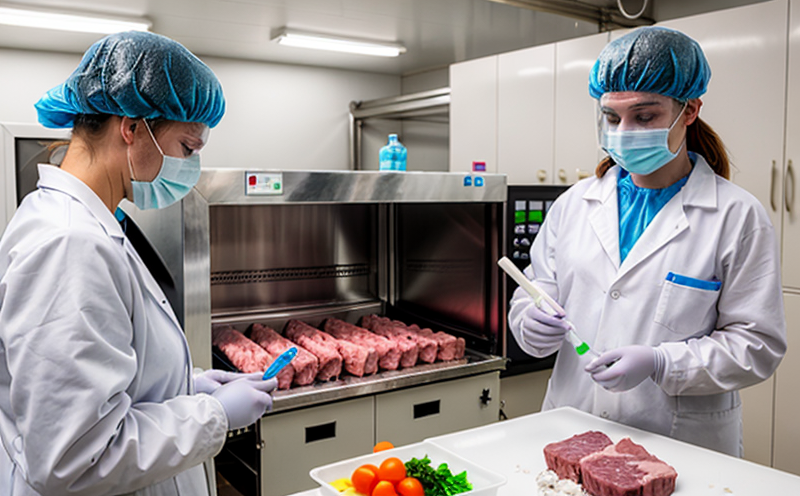EN 12322 Campylobacter Detection in Meat Samples
The EN 12322 method is a standardized procedure used for the detection of Campylobacter spp. in meat samples, particularly chicken and other poultry products. This test is crucial for ensuring food safety as Campylobacter can cause serious gastroenteritis in humans when consumed through contaminated food.
The prevalence of Campylobacter in meat is a significant concern due to the potential health risks associated with its consumption. According to the World Health Organization (WHO), campylobacteriosis is one of the most common causes of bacterial gastroenteritis worldwide. The European Food Safety Authority (EFSA) and the US Centers for Disease Control and Prevention (CDC) have reported that poultry meat is a major source of Campylobacter contamination.
The EN 12322 method ensures that food manufacturers can comply with regulatory requirements, such as those set by the European Union's Food Safety Authority (EFSA). The test involves several steps including sample preparation, enrichment culture, inoculation onto selective media, and confirmation tests. Proper implementation of this standard helps in reducing the risk of Campylobacter transmission to consumers.
The method is designed to be sensitive and specific, using selective media that enhance the detection of Campylobacter spp., such as Campy-BAP agar or other recognized alternatives like CampyMac. The use of these media ensures that even low concentrations of the pathogen can be detected accurately.
The test is performed in a strictly controlled environment to ensure accurate results. Laboratories equipped with advanced microbiological techniques and facilities are essential for ensuring the reliability of the test. This includes the use of appropriate incubation conditions, which typically involve an atmosphere containing 5% CO2, as Campylobacter spp. require this environment to grow properly.
The results from the EN 12322 test are reported in terms of colony-forming units per gram (CFU/g) or CFU/10cm2. These values provide valuable information to food processors about the level of contamination present in their products. This data can be used for quality control, process optimization, and ensuring compliance with national and international standards.
The importance of this test extends beyond just meeting regulatory requirements; it also plays a crucial role in maintaining consumer trust and satisfaction. By adhering to such stringent testing protocols, food producers demonstrate their commitment to producing safe and high-quality products.
Why It Matters
The detection of Campylobacter in meat samples using the EN 12322 method is critical for several reasons:
- Public Health Protection: Ensures that food products do not contain harmful levels of Campylobacter, thereby protecting public health and reducing the incidence of foodborne illness.
- Regulatory Compliance: Helps manufacturers comply with stringent EU regulations on food safety and hygiene.
- Consumer Confidence: Builds trust among consumers by ensuring that the products they purchase are safe to eat.
- Economic Benefits: Reduces the risk of product recalls, litigation, and loss of reputation for brands.
In summary, this test is essential for maintaining food safety standards, supporting regulatory compliance, enhancing consumer trust, and safeguarding the economic interests of food producers.
Scope and Methodology
| Step | Description |
|---|---|
| Sample Collection | Collection of meat samples from various parts of the carcass. |
| Enrichment Culture | Culturing samples in a selective medium containing Campy-BAP agar at 42°C for 48 hours. |
| Inoculation | Inoculating selective media with enriched cultures to enhance detection rates. |
| Confirmation Tests | Use of biochemical tests or PCR to confirm the presence of Campylobacter spp. |
The process begins with the collection of meat samples from different parts of the carcass. These samples are then processed through an enrichment culture step, where they are incubated in a selective medium at 42°C for 48 hours to enhance the growth of Campylobacter spp. Following this, the enriched cultures are inoculated onto selective media such as Campy-BAP agar. Finally, confirmation tests using biochemical methods or polymerase chain reaction (PCR) are performed to identify and confirm the presence of specific species.
The use of selective media like Campy-BAP is crucial in this process because it specifically targets Campylobacter spp., ensuring that only these organisms grow on the medium. This selectivity increases the sensitivity and specificity of the test, making it more reliable for detecting low levels of contamination.
The entire process requires strict adherence to standardized procedures as outlined in the EN 12322. Laboratories performing this test must have the necessary equipment and expertise to ensure accurate results. This includes incubators capable of maintaining precise temperature conditions, laminar flow hoods for aseptic work, and advanced microbiological techniques.
The final step in the process is reporting the results, which are typically expressed as colony-forming units per gram (CFU/g) or CFU/10cm2. These values provide valuable insights into the level of contamination present and help guide corrective actions if necessary.
Why Choose This Test
- Regulatory Compliance: Ensures adherence to EU regulations on food safety and hygiene.
- Enhanced Safety: Reduces the risk of Campylobacter contamination in meat products, thereby enhancing consumer safety.
- Quality Control: Provides valuable data for quality control processes, helping manufacturers optimize their production methods.
- Risk Management: Helps in identifying and addressing potential risks associated with contaminated food products.
- Brand Reputation: Maintains and enhances the reputation of food brands by demonstrating a commitment to high standards of safety and quality.
- Economic Benefits: Prevents costly recalls, lawsuits, and damage to brand image.
The EN 12322 test is widely recognized for its reliability and accuracy. It provides a robust framework for detecting Campylobacter in meat samples, ensuring that food products meet the highest safety standards. By choosing this test, laboratories and food manufacturers can confidently demonstrate their commitment to producing safe and high-quality products.





